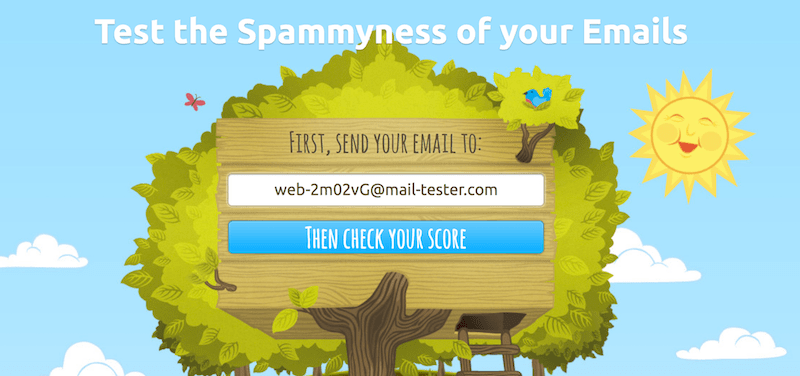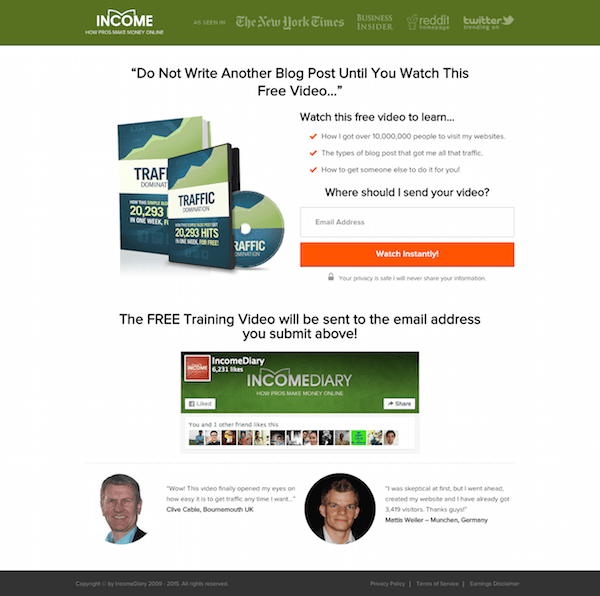The post 7 Reasons You Need To Change PopUp Solutions (or lose money) appeared first on How To Make Money Online.
]]>The majority of websites now get the majority of email subscribers through popups.
Here are 7 ways your popup software isn’t up to scratch:
1. 95% of popups are not mobile responsive
This is something we have mentioned a lot! But I need to emphasize it to you, because, still, in 2016, 95%+ of popups I see, don’t display correctly on smaller screens. I’m not just talking about mobile and tablets, even on my 13inch MacBook Pro, more often than not, the popup doesn’t display correctly.
Popups are often broken, blurry, don’t scale, you can’t close them or you can’t even see the popup all together!
Take into account that over 30% of web users are using mobile, you are potentially missing out on some HUGE gains.
For this one reason alone, it’s worth switching popup software.
It’s important that you go check your website on different browsers and different size screens. Play around with your browser, make it really small to see how your popup adapts. From our experience, it’s very unlikely that the popup software you are using is mobile responsive, even though they may advertise it as being so.
Above all else, this is probably one of PopUp Dominations strongest features. I never have to see a broken popup. You can see in this user review video, how our popups adapt in size as you play around with browser size.

2. WordPress popup plugins are a liability
Every WordPress plugin you have will slow down your website. Slower websites, lower conversions, less traffic.
But that’s not all.
WordPress popups often conflict with existing code on your website which means they don’t work and can end up looking terrible! It’s essentially another thing that could go wrong with your website. And if you are anything like me, there is already enough that can mess up my site, I don’t want anything else to go wrong.
Using PopUp Domination, you don’t need to upload any files, everything is hosted by us. So you don’t have to worry about code conflicts, or our app slowing down your website.
3. Your popup designs suck!
Again, it’s 2016 people. Why do your popups look like the free ones that don’t convert?
PopUp Domination isn’t just a software company, it’s a design company.
Design is everything. It’s what the users see’s. Do you want your brand associated with great design or bad design?
We have an ever-growing popup template library where we release new designs every month!
Every popup can be customized to be any colour, so it will perfectly match your colour scheme.

4. They copy, they don’t innovate
I’m sure you can create some good software if all you do is copy other people. Problem is, you will always be behind the curve. Your users will always get features later than anyone else. And with such a fast pace world, technology is always evolving.
PopUp Domination was first to market back in 2010 and we have been innovating ever since.
5. Your popups gets blocked by ad blockers
What’s the point of paying for software that doesn’t work.
PopUp Domination doesn’t get blocked by blockers.
How is this possible?
We do our best to follow AdBlock guidelines, and offer the ability to exit Popup on any device. If for some reason they decide to block us, we change the code dynamically which will mean our popups will appear again. It’s a lot more complicated than that, but essentially the code was written in a way which makes it very hard to be blocked and if it is blocked, it’s something we can fix very fast.
More than anything, the reason we don’t get blocked is because we keep on top of it.
6. No split testing (or it doesn’t work)
Anyone who knows marketing, knows that split testing is king. It’s the easiest way to make more money because you don’t need more traffic to do so.
Split testing works by putting 2 or more designs against each other in a competition to see which performs best. It’s something we always have running in the background.
It’s surprising how much small design changes can lead to large conversion increase. Test everything from, text, images, colours, etc.
Often when we hear people switching to PopUp Domination from another solution, they tell us that they are doing so because this feature didn’t work with their old software.
7. Customer service stinks!
There is nothing more frustrating than not being able to talk to someone when you have a problem.
A lot of companies are proud to offer 24 hour response times for support. If you ask me, that’s not good enough. If I have a problem, I want it solved, now! And I don’t want a headache trying to figure it out myself. That’s why at PopUp Domination, we offer over 15 hours of live chat every day where our team can help you solve your problem, quick!

There you have it, 7 clear cut reasons why you need to make the switch to PopUp Domination today!
Head on over to our site and if you have any questions, jump on chat and I will be happy to help!
The post 7 Reasons You Need To Change PopUp Solutions (or lose money) appeared first on How To Make Money Online.
]]>The post Email Deliverability: How to avoid spam filters and land in the inbox appeared first on How To Make Money Online.
]]>And that is – the Junk Folder and how to avoid it!
You see, email marketing can be so unfair at times!
You spend hours, sometimes days, creating and fine-tuning a blog post.
When you’re done, you’re pretty confident that you’ve come up with a killer piece of content.
You hit ‘publish’ and post a link to your article up on social media.
Then, as a serious and savvy blogger, you email your mailing list to promote all your hard work.
But in the next few days, the silence is deafening.
You start to feel underwhelmed and discouraged.
After all, you didn’t sweat blood and tears for a small spike in your website traffic and a few measly retweets, right?
The panic starts setting in. Your email analytics are showing some pretty dismal open rates.
You wonder whether your post was actually that good in the first place.
Or worse still, maybe you start to worry that you’re not cut out to be a blogger after all.
The worrying truth about Email Marketing
Well, hold on a sec.
The problem might not actually be with your content.
Maybe the issue is with your emails… and how spam filters see them.
We all know that content promotion is hugely important these days.
However, when it comes to emailing blog subscribers, we face 2 huge obstacles.
Firstly, having your emails land in a recipient’s junk folder is a really common problem.
Getting junked is arguably the most serious issue you face as a content marketer.
According to ReturnPath, only 81% of commercial emails actually reach an inbox.
When you consider that there are over 100 billion emails are sent and received every day, we’re talking about LOADS of unseen outreach (and untapped value].

The second problem we face is slightly more obvious.
The daily bombardment of emails makes it much harder for the outreach messages that actually do get delivered correctly to get noticed.
However, with both these problems, help is at hand.
The good news is that both issues are related and we can kill two birds with one stone.
With a few small tweaks to your outreach strategy, we can fix this and have you reaping the rewards that your epic efforts deserve.
That sounds more like it, doesn’t it?
The big, unseen barrier to the growth of your blog
You probably know how the whole email thing works.
We all have email, and every email service provider has a built-in spam filter to determine the credibility of each message that we receive.
When an email is sent to us, these email filters analyse a bunch of different factors.
Each factor results in a certain amount of points being scored.
Quite simply, the worse your email measures up against the filter’s criteria, the higher the amount of points it scores for each factor.
If the overall points total is too high then forget about it: the email is sent to the junk folder.

Now, it should be said that although email service providers are legally obliged to use spam filters, they’re also there to improve our email experience.
And I guess we should be grateful that spam filters do exist, otherwise we’d be constantly bombarded with daily emails hawking penis enlargement pills, get–rich–quick schemes and singles in your area!
So email filters can wreak havoc with an email marketing campaign, but they’re forcing companies to become more credible.
How to beat the email filters (and boost your blogging ROI)
So the million-dollar question is, what do email filters care about?
Email filters look at a range of technical and content-related things.
You shouldn’t have to worry about the technical stuff, especially if you’re using one of the common email service providers – the likes of MailChimp and AWeber won’t let you down.
Fact is, most emails are labeled as junk because of the content they contain.
Content-related triggers can be obvious or subtle, intentional or unintentional.
11 Email Marketing Tips
Follow this guide to craft the perfect outreach email that will reach your subscriber every time…
1. Take responsibility for your domain.
My first piece of advice is nice and simple: get your domain whitelisted.
You do this by getting a certificate from an authorised source.
Becoming white listed is a way of putting your hand up and saying that you’re responsible for your domain.
And email filters trust these certificates implicitly.
It’s a straightforward process; you just need to find a provider and apply. Certificates aren’t free, but they’re pretty cheap.
For a suggested certificate provider, I’d recommend EmailReg.
You just create an account and submit your domain.
They’ll then do some digging.
Assuming you’re legit, they’ll then sort everything out. A certificate with EmailReg costs $20 and lasts a lifetime.
It’s a total no-brainer; we’re talking about a 5-minute job that you’ll never have to do again.
You will find varying opinions about services like EmailReg online — All I can say is it works for me. I guess some people don’t like paying the $20.
We will discuss WhiteListing later in this post but if you suspect you have been Blacklisted – here is a guide on how to get removed from Email Blacklist.
One other thing – when selecting a domain name, always consider if any of the words used in the domain name are considered ‘spammy’ and likely to set of a spam filter (It has been known to happen)
Finally on this subject here is a rather large list of Email SPAM Trigger Words
Of course issues like this are one of the main reasons Email Marketers end up using Email Services such as Aweber.
2. Avoid using any bizarre email addresses
If there’s one thing that email filters love, it’s an email coming from a source with a clear and consistent brand identity.
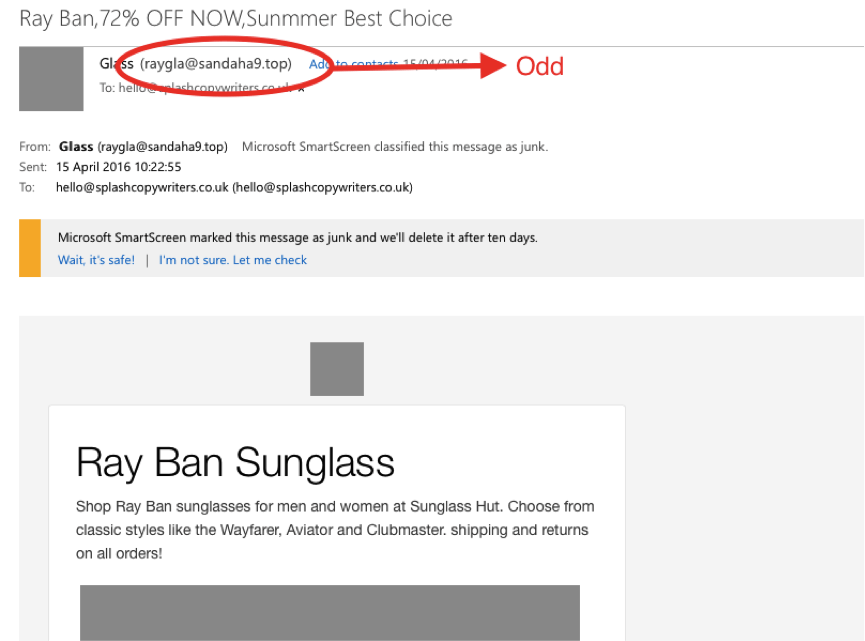
Yahoo! mail is particularly well known for paying attention to the ‘from’ field addresses.
When picking your ‘from’ address, stay away from obscure names like ‘[email protected]’.
Instead, use clear, trustworthy terms like:
contact@
support@
hello@
[your name]@
Also, try not to ever change your address unless you really have to. Consistency is key.
3. Steer clear of any words with a potentially negative context.
Make sure that both the title and the content of your email are written well.
Also, watch out for spelling mistakes:

Remember I mentioned credibility earlier?
Well, one of the biggest culprits for triggering filters is the use of spammy words in your email.
Here is another list of words to avoid in email by Pardot but, in the main, it’s fairly common sense stuff.
For example, avoid phrases like ‘bonus gift’, ‘free prizes’ or ‘don’t delete’.
Got a word you’re not sure about? Then consider how you’d feel if you received an email with it.
Would you think it’s spammy?
Trust your gut. That’ll be the clincher.
A well respected finance guru here in the UK, is Martin Lewis from MoneySavingExpert.com
Mr Lewis is a perfectly credible email source – and at some stage in the past I signed up for his newsletter.
However that didn’t stop his latest email ending up in my junk folder.
Here was the title of the email:

It’s trying to say far too much.
Not only that, but it uses abbreviations and appears like a random collection of words.
This is like email junk bingo.
We’ve got ‘urgent’, ‘cheap’ (twice) and ‘£££’.
It would have been better if the title had used a ‘pipe’ symbol (aka vertical bar) as in example below:

4. Take pride in your brand and have a sense of style.
Interestingly, it’s not only the actual words you’ve chosen that set alarm bells ringing for email service providers.
It’s also the style they’re delivered in and how they’re portrayed.
With that in mind, try to avoid:
- Excessive use of capital letters, exclamation points, or other symbols.
- Using too many different font colors, or bold colors like red and green (I personally don’t see the need for anything other than black).
- Doing strange things with a combination of numbers and letters to try and cheat the filters (such as R3ad th1s 3ma1l!).
- Using font sizes larger than 10 or 12pt.
- Stuffing the copy with unnecessary keywords.
- Sending emails with a host of miss-spellings.
- Fancy symbols in subject lines* (see below)
![]()
*Opinions on using “fancy symbols” vary – some consider it spammy, but others are Fans and using Unicode Symbols in subject lines is growing in popularity.
Ultimately, there’s nothing sinister about email filters. We all receive spammy emails and you can tell them a mile off.
Be authentic and original by all means, just have some awareness and use the eyeball test.
5. Double-check your domain name.
Email filters will look at your domain name very closely, more than the actual email address you’re sending from in fact.
Make sure your URL doesn’t contain any potentially offensive words.
This might surprise, this actually happens a lot by accident.
Take Pen Island Pens for instance, a business that specializes in selling custom-made pens.
They seem to operate out of Pen Island, one of the remote Canadian arctic islands:

With a URL like that, I’d love to see their open rates.
5. Go easy on the links.
Don’t incorporate too many links within your email, even if they are to your own site.
If you’re linking out to external sites, make sure that they’re reputable domains too.
Limiting links isn’t just something for the benefit of email filters either.
Frankly, it’s annoying to receive an email with a load of links.
Even if a message with too many links did reach the intended recipient, is it actually going to be effective?
It’s asking too much of the reader.
Having multiple links is like trying to open a conversation with someone by offering 10 possible topics to choose from.
It’s weird and it won’t help you reach your goal.
6. Take care when including images within an email.
Email filters are also known to have a big issue with images:

M&M direct are another bona fide company who should have no problem in sending an email.
But they sent me too many images.
Looking at their email template, there was space allocated for at least 8 pictures, if not more.
I saw none of them.
Exceptionally large images will be a problem, as will having too many images stuffed into a single email in relation to the amount of text.
As an additional piece of housekeeping, ensure that any images you do include within an email are being hosted at a reputable site (something that’s often overlooked).
It’s worth knowing that a lot of email clients automatically block images.
Because of that, the chances are, even if your image-heavy emails do make it to the inbox folder, your recipients won’t see the pictures anyway.
7. Give your recipients a clear ‘unsubscribe’ option.
This is a biggie.
Not having an obvious way of unsubscribing from your newsletter is email suicide.
This might seem obvious, but you’d be surprised at how many people don’t do this (either intentionally or otherwise).
And talking of intentionally trying to beat the system…
8. Never try to pull a fast one and trick an email filter.
Dealing with email filters is a little bit like dealing with Google in SEO.
Make sure that you DON’T:
- Have email subject titles with Re: or Fwd: and make out like there’s been a previous conversation.
- Create words out of symbols, such as F.REE.
- Send any misleading claims.
- Include any images that conceal text.
Here’s an unimaginative email title from a bogus ‘Barclays’ bank:
![]()
This is a better attempt, but with an attachment from an unknown source, it’s still going to fail:
![]()
9. Show your mailing list some love.
If ‘the money is in the list’ is the most over-used cliché in marketing, then ‘look after your list’ has to be the most under-used one.
For a quick win, practice good list management if you want to make sure that your email campaign is successful.
It’s a question of pure logic.
If you’ve sent a number of emails to a prospect and seen no engagement, they should be removed from your mailing lists.
Email filters look at open rates and bounce rates too, so if you don’t stop sending emails to inactive people, the situation is only going to get worse.
The more times you get marked up as spam, the more often it’ll happen.
With me, Groupon are the big losers in this area:

I bought one thing from Groupon about a year ago; now I get daily emails from them.
One probably got sent to my junk folder…
… but now they all do, because Outlook’s email filter is clever enough to recognise that I’ve not dragged anything back to my inbox.
Likewise with Smyth’s toys, the message is loud and clear:

10. Ask your email subscribers to whitelist you.
The elephant in the room.
Yup, one of the best ways to make sure that your mailing list receives your emails is right under your nose.
Just ask them to add you to their contacts!
Even if just a few subscribers do that, it’s a step in the right direction.
This technique is particularly useful at the beginning of your relationship with a new subscriber.
Simply send them a welcome email and ask the question.
Just remember that even if everyone on your email list has agreed to receive mail from you, you should still provide a prominent ‘unsubscribe’ link in your emails.
How to whitelist an email address with Gmail, Outlook.com or Yahoo! Mail
11. Use a tool and become an email Jedi.
There are a number of tools that can help you predict whether how authentic your email might appear.
For instance:
- SenderScore.org can give you an insight into what your customers think of your email campaign, and show you the overall health of your current program.
- Blacklist checks can help you to find out whether your IP has been blacklisted or marked by email providers.
- Tools such as MailingCheck, IsNotSpam and MailTester can evaluate the content of your email for spam.
Now you’ve got an action plan.
If your emails aren’t getting seen, then at best, you’re wasting time and effort.
At worst, you’re leaving traffic, revenue and growth on the table.
Are you happy with that?
Thought not.
Follow those 11 tips and the next time you’re ready to promote one of your babies, you can blast your mailing list without a second thought.
And that way, you’re next job will be a nice one.
You’ll be thinking of your next article rather than stressing over the last one.
You’ll be busy creating another masterpiece, not trying to justify starting this whole painful cycle all over again.
Author Bio: Matt Press is an experienced copywriter who has written words for some of the UK’s biggest brands, such as Sky, Three and Vodafone. He now runs his own copywriting agency, Splash Copywriters.
IncomeDiary Update:
1) GMAIL and Clipping your message
Gmail being the efficient service it is, clips HTML emails that are larger than 102 KB
Which means that if your message is greater than 102 KB you will see something like this: [referred to as Message Clipping]

Not exactly what the sender intended!
Not only does the receiver not see your intended message – they will often miss the ‘view entire message’ link.
Worse still, if they cannot see the intended message and an un-subscribe link, there is a real risk of your legitimate email being marked as spam!
A couple of tips:
(a) Stop copy and pasting your email from in particular a WORD DOC (it creates unnecessary HTML that bulks up the message size)
(b) Instead, create your email as a simple text file. A great online service you can use for this is: EditPad
With EditPad it is easy to download and save a clean text file to say your Desktop. Then it is just a case of Copy and Pasting the content of your email into AWEBER, Mailchimp etc.
More information here: Tips To Avoid Message Clipping In Gmail
2) It is a matter of balance
We had long suspected that using words like Spam or Inbox in an email triggered spam filters. But that did not stop us using “How to avoid spam filters and land in the inbox” as an alternative subject line in a recent email to our subscribers.
As you can guess, a number of our emails ended up in the Junk Folder.
We learned two things from this…
- A good number of people check their Junk Folder.
- The open rate and clicks % for this subject line was actually higher than an alternative email we sent that did not include those trigger words.
It is a matter of balance – we know our audience wanted to know about Spam Filters – and sometimes if you want to reach people and get the interaction you desire you need to ‘break the rules”. In a busy world with a huge number of emails going into peoples inboxes sometimes you will have to take a risk with subject lines.
#Tip Always use alternative subject lines and measure the response on each. Services like Aweber allow you to email subscribers who did not open an email. When emailing the ‘unopens’ use an alternative subject line. It is not unusual to find that the second email to ‘unopens’ gets a better response.
You should also test sending at different times of day and days of the week.
More Email Marketing Resources
=> 29 Email Marketing Resources To Help You Master Email
=> 14 Ways to Make More Money From Email Marketing
=> Marketers Guide to Maintaining Your Email List
The post Email Deliverability: How to avoid spam filters and land in the inbox appeared first on How To Make Money Online.
]]>The post 5 Different Ways To Get Email Subscribers – What Converted Best? appeared first on How To Make Money Online.
]]>Over the years, we have had 100,000’s of people sign up for our mailing list, so today I thought it would be a good idea to share with you what works best when trying to get email subscribers.
You ask any top marketer, what is their most important marketing tool, they will tell you it’s email.
Why?
Because nothing is as consistent as email marketing.
With the click of a button, you can instantly send an email to a group of people with your offer. You don’t have to wait for them to come to you. They have already shown interest and want you to email them.
Take a look over the last 10 years.
Google Adsense was the go to way to make money from a website. You could earn over a $1 a click. Some people made as much as $25 a click. It was brilliant. People coming to your website didn’t even know what the ads looked like and would click them all day long.
As time went on, more websites used it, with more people offering clicks, the earnings per click went down. Web users learned what ads looked like and stopped clicking them as much. Google’s terms got more strict. Eventually website owners started looking for something new to make them money.
Then came Text-Link-Ads.
Website owners used this site to sell text links on their site.
A large part of Google’s ranking algorithm is based on how many quality links you have pointing to your website. This meant big companies were happy to pay a premium to get links, to push up their search engine rankings, getting them more traffic and making them more money.
You could add 10 links to your sidebar and make $1000/month.
Even sites with low traffic could charge a lot for links because people weren’t buying links based on traffic, but how much Google liked their site.
Google hated this.
Google wants to show users the best possible match for their search. Not those who cheat the system.
As time went on, Google started punishing sites who bought and sold links. Quickly the price of links dropped and everyone was left looking for a new way to make money.
When Twitter came along, website owners could sell promotional Tweets to their followers. Over time, quite quickly in fact, Twitter became to busy, there was to many people competing for attention, Tweets started to perform less and thus, people stopped buying Tweets.
There are dozens of examples of monetization techniques making people rich, but over time… stopped working.
Email marketing has remained consistent. That’s why top marketers focus on their list above all else.
Even if email dies one day… marketers will still focus on their lists. Before email, marketers would send letters in the post. After email, who knows how they will contact their list, but there will be a way and it will continue to perform.
That’s why you should focus on your list.
What Works Best To Get Email Subscribers From a Blog
Over the last 11 years, we have tried and tested dozens of different techniques to build our list.
We wanted to know what are the best ways and in what order do they perform.
So over the last two weeks, we tested the 5 most popular ways to show signup forms on a website.
They are:
- The top of the homepage
- Bottom of posts
- Sidebar
- Squeeze page’s
- PopUp’s
Below is a breakdown of how well they did.
Before you continue, take a minute to think, in what order do you think they came?
The Results

Total new subscribers: 4382
- PopUp Domination brought in 2,803 new subscribers – 63.9%
- Footer Signup brought in 774 new subscribers – 17.6%
- Homepage Signup brought in 309 new subscribers – 7%
- Squeeze Page brought in 296 new subscribers – 6.7%
- Sidebar Signup brought in 200 new subscribers – 4.5%
All 5 techniques were active at the same time, competing against each other.
It’s worth mentioning that all of our traffic for this test is from free traffic sources, interested in a wide range of subjects. (which explains our low conversion rate)
Continue below to see a breakdown of why they performed the way they did.
Getting Email Subscribers From a Homepage Header Box
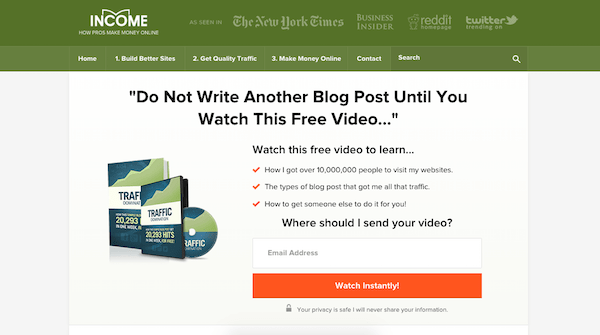
We first added an opt-in box to our homepage back in 2007.
In 2009 we decided to try something bigger, we added a full width opt-in box right under our header.
Overnight we saw a huge increase in new subscribers.
At the time, hardly anyone was displaying opt-in boxes like this. Now you see them everywhere and for good reason.
Most people who visit your homepage will come from other pages on your website. They come to your homepage because they have seen something that has made them interested enough in you that they wanted to stay and look around. Because of this, your homepage is one of the highest converting pages on your website.
Getting Email Subscribers With Below Blog Post Opt-in Boxes
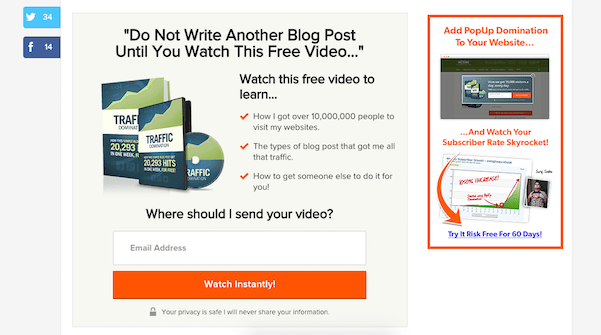
Having a subscription box below blog posts is a good idea because visitors have just read your post. Your post has just sold them on who you are and the value you can deliver.
Placement is everything. The difference between putting this box at the bottom of the page and the bottom of a post can be as much as 500%.
Getting Email Subscribers From Sidebar Signup Forms
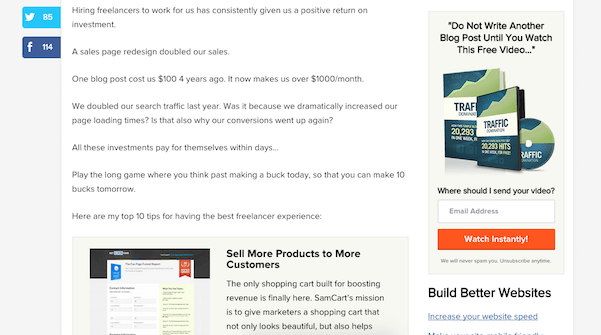
The sidebar is probably the most common place you will see an opt-in box.
It’s also the lowest converting signup form on our site.
Why is this?
Could it be because you have less space to promote your offer?
Is it because people are use to seeing it and switch off?
Or perhaps it’s because all the other techniques grab their attention first.
It performed so badly for us that we have decided to delete our sidebar signup. It isn’t worth it. It takes up a lot of space that could be better used to direct people to more content. The more content users see, the more opt-ins we get and the more sales we make.
Getting Email Subscribers From Squeeze Pages
Every website needs a squeeze page.
It’s a page that’s soul purpose is to promote your email list.
You can link to it in posts, emails, adverts. Subscribers can use this link to tell their friends how good your emails are and to go here to sign up.
Often, I will be writing something and want to reference my mailing list. It’s a lot easier to link to your squeeze page then to tell a reader the location on a page to go to and sign up.
Use Optimizepress to create high converting squeeze pages effortlessly.
Getting Email Subscribers From PopUps
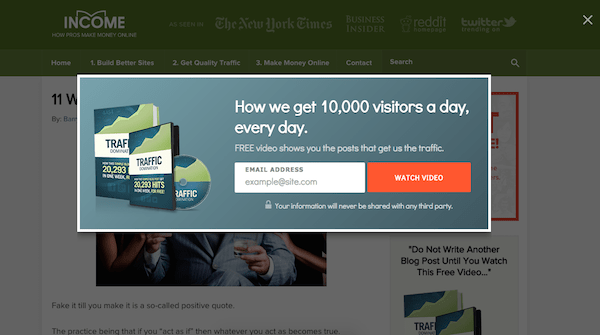
The almighty popup. Just 7 years ago it was rare to see one. In 2017, they are used by the majority of websites.
I’m sorry.
A big reason for that is because of us.
Five years ago, I was having a conversation with a guy at an event about how his site was using them to get email subscribers. It was by far the most powerful tool he was using to skyrocket his mailing list.
I wanted in.
I searched for an easy way to add a popup opt-in box to my website. The best I could find was a simple white box which would only allow me to edit the text.
But I wanted a popup that looked and converted great!
So as soon as I got back from the marketing event I spoke with my designer and asked him to make me one.
Overnight our email subscribers jumped by over 507%.
OVERNIGHT.
Never have I seen something blow up so quickly.
I was now getting as many new subscribers as the big guys in my industry but with a fraction of the traffic.
On a call the next day, I told my designer about the results. I dropped the suggestion that it could be a good idea to go into business together and build a WordPress plugin so that other websites could easily add a popup to their site. He would supply his web development team and I would bring my marketing skills.
I did for a brief moment think to myself, perhaps it’s not a good idea to release this because it works so well. Perhaps I should keep this to myself, my secret edge. But I knew it would be big and if I didn’t do it eventually someone else would.
We worked round the clock for 11 days to build the first version. A time frame we gave ourselves because we were concerned that another marketer was working on a similar project. In the end, they were working on something else.
In our first week, we sold over 500 copies.
At the time, a lot of top bloggers spoke publicly about how they didn’t like it and were against us. Now they all have popups on their sites.
Over the years that followed we have invested 1000’s of hours on development.
Today, over 60,000 websites are actively using our software.
What you need to know about PopUps
It’s the No. 1 way to build your list, by far!
Why?
Because it’s kinda hard to miss.
You see it before any other signup form.
So how can you get your own and what’s important?
Go to PopUpDomination.com and signup for our FREE 14 day trial.
As for tips for getting the most out of your popup:
Test everything.
Try different popup designs, colours, copy and promotional images. Split test something new every week to increase conversions.
Display different popups based on category. If you have one popup, not every reader will be interested in what you have to offer. Setup different offers for each category to put your email marketing on steroids.
Display settings matter. Work out how often to display your popups and after how many pageviews/seconds on page.
That’s it.
If you can only use one email marketing technique to get email subscribers, you should be using PopUp Domination.
The post 5 Different Ways To Get Email Subscribers – What Converted Best? appeared first on How To Make Money Online.
]]>The post 10 Reasons Why You Suck at Email Marketing appeared first on How To Make Money Online.
]]>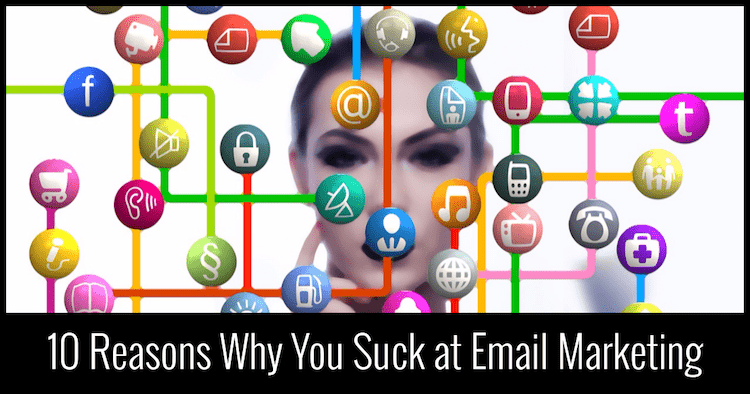
10 Reasons Why You Suck at Email Marketing
Did you know than an email open rate of around 20% is considered very good?
Or that a click through rate of 2 to 4% is considered typical? (depending on industry)
Look at this 2016 stats for three different markets…
Daily Deals/E-Coupons: 13.87% Open rate and a 1.81% Click rate
Education and Training: 21.96% Open Rate and a 2.75% Click Rate
Hobbies on the other hand enjoy some of the best open rates and click-through rates.
Hobbies: 28.85% Open rate and a 5.41% Click-through rate
It may not look good – but this is the reality of Email Marketing!
Indeed, some marketers and brands are excited if they get more than 1% of their list clicking on links.
Does that sound familiar?
Let’s face it, when you are off the mark on your emails, it has devastating consequences.
The biggest is the hit you’re going to take to your bank account.
No one likes that.
But the ripple effect can continue on. Bad email marketing campaigns can not only shrink any potential income, but they can also damage your brand.
It’s unbelievable how many marketers and brands are willing to blow lots of money that should be coming their way because their email marketing is terrible.
Thankfully, there are ways to fix that.
You don’t have to be one of legions of marketers and brands who suck at email marketing.
If you’ve been seeing dismal numbers on your email marketing metrics, there are reasons behind them.
Today, I’m going to show you 10 reasons why your email marketing sucks (and how to fix it).
Let’s go.
#1. You Don’t Know Your Audience
If you don’t deeply understand who you are speaking to before you even start emailing, you’re sunk already. Your subscribers have given you something precious, their email addresses, don’t take advantage of that.
When you’re list is full of 25 year old guys who are into kettle-bells and they are suddenly offered a product on losing baby fat, you’ve set yourself up for disaster. Now your list knows you don’t know anything about them, so don’t be surprised by not only a loss of trust, but also a tidal wave of unsubscribes.
Avoid this by paying attention to what your audience likes and responds to. Since you are selling them on your product or service, you should have already done your due diligence and have a good idea of who you are targeting.
#2. You’re All About Selling
Yes, the end goal of pretty much any email marketing campaign is to get your subscribers to buy a product or service. We all know that, but that doesn’t mean you need to be selling them round the clock. In fact, if you are, you’re blowing it.
The best email campaigns work out a balance and lead their readers on a journey towards the sale. They warm up potential customers by offering them value, telling stories and building a connection with their readers. Then, when it comes time to actually buy, the decision for your reader is often a no-brainer.
#3. Your Subject Lines Stink
You’re never actually going to sell anything with your emails if no one opens them. Some of the biggest culprits of a bad email marketing campaign are poorly written subject lines that don’t inspire anyone to actually click.
Rather than sending out emails with boring subject lines, you can do better. Try thinking creatively, be interesting, engage a bit of curiosity and ask questions to start. You know what makes you want to click when you see an email in your inbox, use those same ideas with your own campaigns.
Just fixing this single issue alone can help increase your click through rates because you’ll have more people actually opening your emails.
#4. You’re Inconsistent
Now, you don’t have to send your newsletter every Tuesday at exactly 4:37pm to see success, but you need to establish consistency with your email marketing campaigns for the best results.
If you email too often, you run the risk of overwhelming your subscribers and losing them. If you email once every 6 months, then your readers are never going to remember who the hell you were in the first place. Let your subscribers know when (and how often) they can expect emails from you, with both campaigns and newsletters.
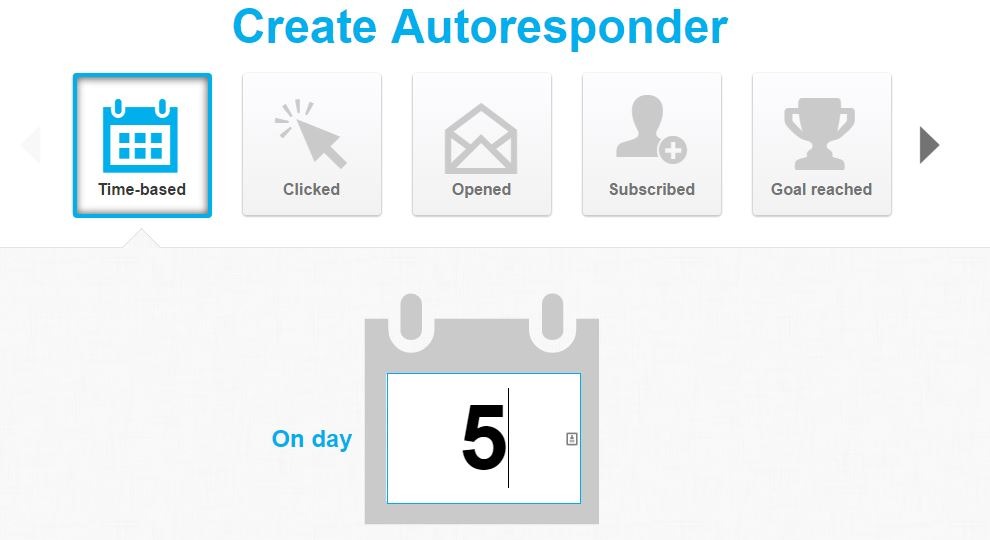
#5. You’re a Brand, Not a Person
Part of connecting with your readers is being approachable (and yes, even likable). People like to know there is a person behind the brand not just a automated robot, so stop hiding that in your emails.
When you use your brand name in your “from field” it can send the wrong impression, turn readers off or even make them think they are getting spam.
You know what happens then, right? Email meet trash bin.
Instead, use your name front and center and use your personality to build a relation with your readers that enhances the brand.
#6. You Have Terrible Copy
Copy is a lot more than just dropping a few clever words down on the page, clicking send and calling it a day. Your entire campaign can be won or lost in your copy, and most people are losing…badly.
Here’s where you can be better. Start by studying. There are plenty of masters of copy out there who can help you improve your content dramatically, making it fun and easy to read. Guys like Gary Halbert, Dan Kennedy and Gene Schwartz are all people who you can learn from.
If you don’t have the time, or the skill, to tackle email copywriting then outsource it to an expert. Improved copy will not only pay for itself almost instantly, but will also save you the time and headache of getting it right.
#7. You Don’t Test
Come on, you have to know by now that testing everything you send out is really important. So why aren’t you doing it yet? If you’re afraid to see the numbers, it’s time to get over it and start testing and tracking, now.
Once you do start testing, the data you collect can lead to a wealth of information about your list. You could see that while you have great open rates no one is clicking, or that you have bad open rates but high clicks, or just bad everything, ouch.
You can’t start improving your email marketing until you have an idea of what’s not working. And you’re never going to know that until you take a deep dive into the data.
#8. You Don’t Make it About Them
Getting your email subscribers to take action in your emails involves hard work. Too many brands and marketers make their emails all about them, not their potential customers, instead of what they like and want to say.
Move away from the pack and make your emails all about your readers. Find (by testing) and understand what drives the passions of your email list. And then appeal to that.
Some of the biggest and most successful email marketing campaigns are those that have a cultivated an amazing relationship between the brand and the list. It’s these customers who will always keep coming back for more.
#9. You’re Not Using Call to Actions
Congrats, you have an amazing subject line that drives opens, the perfect product or service for your list, and great copy.
Guess what? Nothing is going to happen if you aren’t sending emails that have a clear purpose and direction.
One of the most vital parts of any email is how you tell your readers to do something. That means buying a product, signing up for a webinar, downloading an ebook, you name it. If you aren’t specifically telling your readers to do something they won’t do anything and you miss out.
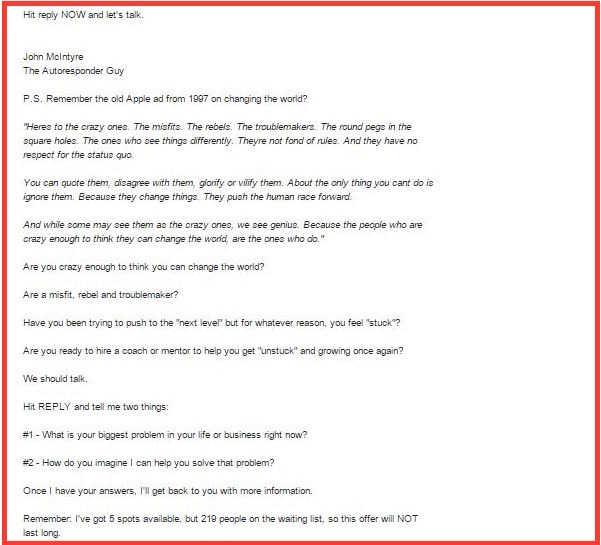
#10. You Aren’t Following Up
This is a two fold issue for many brands and marketers. And neither is very good.
On one hand, some brands and marketers send out their first campaign and then…crickets. They don’t follow up on the campaign they sent. And then there are those who don’t respond to their customer’s emails.
Both of these are huge mistakes. You’ve spent so much time building up a relationship with your list subscribers and then you blow it by not paying attention when it counts. You should always (always!) reply to any emails from people on your list. And don’t leave your potential customers hanging by disappearing after your first campaign.
Bonus: #11. You’re Not Collecting Emails
All of this advice is for nothing if you haven’t even begun collecting email addresses from potential customers yet. If that’s the case, you can’t start doing this soon enough, like today.
Set up your website to grab opt-ins and build that list. This is one of the most important things you can do from the very beginning to help pave the way to marketing riches from the start. You’re never going to have success in email marketing if you have no one to email.
So, get on it!
Want To Master Email Copywriting?
Want to write emails that get a response?
Want to really connect with your subscriber?
Want to make more money, either as an email copywriter or promoting your own products?
Then you need this…
4-Week Email Copywriting Masterclass
John McIntyre will show you in 4 Weeks, How To Create A Brutally Effective Email Autoresponder Sequence That You Can Sell To Clients For $200 to $1,000 (Or Hey, Use It To Grow Your Own Business)
The post 10 Reasons Why You Suck at Email Marketing appeared first on How To Make Money Online.
]]>The post 12 Powerful Tips to Dramatically Increase Email Open Rate appeared first on How To Make Money Online.
]]>This will help…

People are always talking about money being in the list.
But what good is a list of subscribers if you can’t get anybody to open your messages?
Email marketing is only a virtual cash machine when done right.
But before you’re making the big bucks mesmerizing your subscribers, you need to build your list by capturing emails.
I highly suggest utilizing Popup Domination to do just that.
It’s proven time after time to increase subscribers by 524% overnight. Over 35,000 websites are currently using it!
And while Popup Domination is a great tool to help build your list, you’re still going to need to get all those new subscribers to open your messages.
I’m not only going to show you how to get your emails opened but how to actually have people looking for them.
Here are 12 powerful tips to increase open rate:
#1. Make It Personal
These days, our inboxes fill up quick and a lot of times get flooded with junk mail. We all deal with it.
We sign up for some product or newsletter that looks promising only to be inundated with spam and nonstop affiliate offers.
One of the easiest tactical approaches many use to filter nonsense is seeking out their names.
Make sure you’re collecting first names with your email capture and personalizing subject lines with first name. This is an instant attention grabber and subtle trust builder.
#2. Have A Double Opt-in
I know it’s hard to choose between list size and list quality and I’ll be up front with you, your list will be smaller with a double opt-in.
BUT…
It will be much higher quality!
Think about it, your subscriber just proved they’re opening and clicking your links. Whatever it is you’re offering they’re seriously interested.
If you offer something of great value, you don’t need a massive list to make a living. Just don’t forget your subscriber jumped through a couple hoops – reward them to show your appreciation.
#3. Get Mobile Optimized
Nearly everybody has a smart phone, in fact, there’s a growing belief that in the near future we’ll exclusively use phones for email, work, shopping et cetera.
133.7 million people own smart phones in the US alone and 43% of all email worldwide is opened on mobile devices as of April of last year.
People are using their phones to check email now more than ever…
And if the links in your email are always leading back to a site that’s not mobile optimized they’ll stop opening because it’s a pain in the neck to deal with.
#4. Use Enticing Subject Lines
This should be a no-brainer, but I still observe marketers using dry and boring headlines.
Just this week I was consulting a friend who’s getting his feet wet in online marketing… I suggested he get into it, because he’s a natural salesman.
I know he doesn’t have a sales background and asked if there was something specific helping him create fantastic headlines.
Without hesitation he says, “sea-puck.” He meant CPUQ. and it stands for controversy, power-words, urgency, questions.
Those are the only styles you need to utilize in order to craft irresistible headlines… And here’s an example of each:
Controversy Power Words Urgency Questions
A Little Mistake That Cost a Farmer $3,000 a Year YOU Can Make BIG MONEY EASILY Warning: Read This NOW Or Kiss The Rest Of Your Money Goodbye Free Website Review: What Do You Struggle with Online?
But What if You Could See Her Naked? OUTSTANDING Methods Are The SPECIAL EDGE For Open Rates What You Must Buy And Sale Now: The ONLY Way To Protect Your Weatlth Are You Frustrated By Internet Marketing?
Nazi UFOs to attack U.S. HILARIOUS CONFESSIONS Of Real DESPERATE Housewives What You Must Do Immediately To Rank In Google Are You Making These Blogging Mistakes?
#5. Offer Real Value Consistently
You’d think this is obvious, especially with how I opened this post saying email marketing was like a cash machine.
While I still consider that to be a spot on analogy, you have to understand it’s only possible by offering fantastic content from the get go and not stopping.
Once people understand that you care and truly want to share high quality information with the world they’ll be looking forward to your products and recommendations.
But nothing will get you marked as spam or unsubscribed from quicker than constantly pounding your list with offer after offer. The only people that get away with this are those with MASSIVE, 100k + lists that can afford to lose a few subscribers.
#6. Build A Relationship With The Reader
The best way to manage your online reputation is to build strong relationships. That goes beyond email marketing, it should be your goal with all of your interactions online.
You’re the premier representative of your brand so hold yourself to a high standard and your work will reflect that.
People will give you great reviews, testimonials and leave positive comments on your various content. You’ll find loyal fans silencing haters for you which is always great for brand management.
Loyalty must be earned, it cannot be bought.
#7. Have An Open Loop
These are fun because you get to sharpen your storytelling skills.
Basically you build up anticipation by giving the impression you’re about to reveal some outstanding information and always make them wait until tomorrow by coming back around to the beginning of your story.
You’re giving information, but you’re disguising it…
For instance, here’s a really quick example. Matter of fact, what I’m about about to show you, took me 2 hard years online to figure out, spending thousands on products that were supposed to put my business on auto-pilot…
I nearly went bankrupt and then it finally hit me!
What I discovered was so blatantly obvious and simple, I made over 4k my very first day. And it didn’t cost me a penny.
All I had to do was use google trends and open loops to see a 720% increase in traffic, it was that powerful … I could rinse and repeat forever.
I mentioned it to my friend who had been marketing for years, but he brushed off the thought of quality free traffic.
So I showed his little brother, a complete “noob.” I gotta tell ya, he’s the only 17 year old I know driving an M3 that he paid for – cash.
Not bad for open loops and Google trends?
You’re going to want to see how you can do what this 17 year old did… I’ll tell you all about it tomorrow.
See what I did there?
#8. Clean Up Your List
It’s normal to get inactive subscribers but sometimes they just need a refresher.
There are two simple methods you can use…
The first is send an email reconfirming they want to be on your list. You can do this through Aweber or whatever auto-responder you’re using.
The second thing I do when a subscriber has been inactive for a month is put them on a separate list where they’ll no longer be mailed daily.
I’ll hit them with 1 more daily email blast and a reconfirmation 7-14 days later, if neither get’s opened they’re removed completely. You can typically automate this entire process through your auto-responder’s “list segment” option.
#9. Remain Consistent With Delivery Time
When I’d send emails at inconsistent times the open rate was much lower compared to mailing at the same time daily.
All major auto-responders have an option to have your message sent out at a specific date and time.
I use Aweber and usually set my followups to “send 1 day after previous” which sends at the time the individual received that last email which is the same time they signed up. Be sure to have several emails queued in advance.
#10. Run Split tests
If most of your content is the same for all subscribers, you can run several split tests to identify what resonates best with your audience.
I’ll test several different mail-out times based on time of day in PST, EST & GMT. Typically I’ll test 8am, 2pm and 6pm mail-out times for each timezone and set my broadcasts to the most active.
The second is test what CPUQs are getting opened the most and include that style in the subject lines more frequently.
The third thing to test is whether it’s best to have messages coming from myself or the brand. Typically it’s best to have your emails “from” a person, but I’ve seen otherwise, which is why I test.
#11. Great First Impression

How many times have you heard, first impressions are everything?
Well they are, and the same is true online. Your first impression is your best shot at earning trust and ensuring future emails get opened.
Assuming you’re already running a clean email capture software like Popup Domination to grab attention and build your list, it’s crucial to give away awesome content like problem solving reports, info-graphics, podcasts and videos.
#12. Have A Second Lead Magnet
This next tip is perhaps one of the most effective things I’ve ever done to dramatically increase open rate…
Creating a second lead magnet in the form of an eCourse, audio or video series spread out over several days is a clever and incredibly effective way to get your emails opened and consumed.
You’ll notice Income Diary employing this very method with their Free 7 day money making eCourse…
A great way of enhancing the relationship with your list is simply surveying them from time to time.
This will help clearly identify what problem it is that you’re audience needs solving. Once you identify what that “problem” is, make it a point to over-deliver on the solution.
Always try to empathize and respect your reader. You’ll have no problem earning a living online if offering high value is 100% of your mission,
Don’t meet expectation, exceed it!
Success by choice, not by chance.
– David Aston
Read more: ‘10 “Fill In The Blank” Email Subject Lines (That Made Me The Most Money)’
The post 12 Powerful Tips to Dramatically Increase Email Open Rate appeared first on How To Make Money Online.
]]>The post 10 Different Ways I Use PopUp Domination At Once appeared first on How To Make Money Online.
]]>Since the early versions of PopUp Domination, the plugin has grown to include more themes, as well as shortcodes so that we can enter subscription forms about our website, such as in the footer and sidebar.
I use various themes from the premium theme pack at once, so that I can convert the most amount of visitors possible while keeping the offers relevant.
It’s helped me to build multiple lists, so I’ve written this post to show you the different ways I use PopUp Domination.
It may be more powerful than you realise – I use 6 different popups at once.
My Top Tips For Using PopUp Domination On Your Website
1. Exit PopUp Tool
This is my go-to popup, and where most of my opt-ins come from. I’m constantly updating this with one of the 28+ themes available, to see which provides me with the best conversion rate.
It’s set so that when you leave my page, the popup appears, asking for your email address in return for a free ebook.
I A/B tested it earlier this year, and I found that I got a better conversion rate by asking for people’s email addresses as they were leaving, rather than when they land on the page.
It makes sense really because when they’re arriving on the page, they’re looking for something, and when you display a pop up straight away, they’re more likely to get rid of it and find what they came for.

2. Display PopUp On Click
This feature is cool because instead of you choosing when the popup appears, the visitors does.
We have a free eBook teaching bloggers how to get more traffic. When we write blog posts about driving traffic to your website, we can add a link in the post that makes our popup appear, offering the free eBook.
Another option is, instead of using adverts to send traffic to your squeeze page, you can display your popup instead. This is great because, instead of a visitor having to load another page, they can signup straight away.

3. Countdown Sales PopUp
Every time I run a sale for one of my products, I add a count down popup to my landing page. This works great because it adds scarcity. People see it and think, this is a great offer and I don’t have much time to decide if I should buy it.
It significantly boosts conversions because visitors don’t want to feel like they missed out on a great deal!
I find that the first day and last day of my sale, I do the majority of sales and it’s because I have a countdown.

4. Mobile PopUp’s
With version 4 of PopUp Domination, you can now display your popups only on mobile devices.
Also, all popup designs are fully responsive, which means they will change in size, depending on the device they are viewed on.
With over 30% of my traffic coming from mobile, this feature is very important!

5. Video PopUp
Sometimes, video just works best.
I have various video sales letters, from the short and sweet, to the 15 minute long informational videos, and it’s good to be able to display these videos on relevant pages.
For example, I recently created a 7-day video course, for free, to help promote my paid course. I had a video popup appear to visitors on the pages where the topics were mentioned, asking them to opt in.
This way, I can talk to them through the medium they will expect to see me though, and I’m only targeting relevant content.
It also means that I can use my regular popups on the other pages.

6. For Establishing Interest in a New Product Idea
This is an awesome trick, if I may say so myself.
I’m testing the market for a new course on composition because it’s not worth me creating the course until I know whether there’s interest or not. Otherwise, I’ll do months of work, for very little return.
I create a popup with a similar offer to the product that I’m going to create.
For me, I’m thinking about creating a photography composition product. So I created a popup, offering a free composition video I’d made, in return for their email address. Then I go into the Analytics in PopUp Domination and look at the conversion rate. If it’s good enough, I will create the course.
And if I do launch the course, I have a list of potential buyers.
I only make this popup appear in the composition category.

7. Using PopUp’s To Offer Discounts and Free Trials
One of the best things you can do for increasing conversions on a sales page is to offer a FREE trial or a discount.
What we do is, we let visitors checkout our sales page, if they go to leave without buying, we show a popup offering them a free 14 day trial.
This converts very well for us!

8. Product Announcements PopUp
One of the most important things you can do when you run a membership website or sell software, is to keep it updated.
When you release updates, you want to tell everyone about it.
What I like to do is, add a popup, letting everyone know what the update is. This appears when a user logins in for the first time since the update.
Below you can see the popup we used to announce that we released our affiliate program.

9. PopUp Analytics Tool
If you work online, and you don’t know your data, then you’re just lazy.
One of the key ways to earn more money is to improve your conversion rate for more leads, or sales.
So for that reason, every page that could potentially lead to a conversion of some kind, is always being tested, and I’m always looking at the analytics.
PopUps are an incredibly powerful too, but you’ll never know how powerful it could be, without the use of analytics.

10. PopUp A/B Testing To Increase Conversions
Always be testing.
There’s always unlocked potential in your opt-in pages and popups, but you never know what’s going to convert best until you test it.
I initially tested a few different themes against each other, but when I found one I liked, that converted well, I then switched by making adjustments to one theme.
I test colour, heading, the length of bullet point, and my favourite point of all; button text.

To recap, here are some of my favourite PopUp Domination features:
Email Themes, Redirect Themes, Countdown Themes, A/B Testing, PopUp Triggers, OnClick PopUps, Exit PopUps, Analytics, Super Fast, Responsive Themes, Custom HTML/CSS/JS, Geographical Targeting, Page Specific PopUps, Referral Sites, Notification Popups.
As for my business, well my main source of income comes from my email list, so it makes sense for me to do everything I can to get more subscribers.
You may consider me to be bias, as the product was created by my brother, but I can say for certain that my business would not be where it is now without the use of PopUp Domination.
Along with OptimizePress, this is just one of the plugins that are essential to my business.
You can also follow PopUp Domination on Facebook and Twitter
The post 10 Different Ways I Use PopUp Domination At Once appeared first on How To Make Money Online.
]]>The post 10 Lessons I Learned From My First 20,000 Email Subscribers appeared first on How To Make Money Online.
]]>When it comes to making money online, you need to have a relevant list of email subscribers that you can call upon.
It’s direct, and easy to do.
I tried to launch my first product with just a few hundred people on my list.
And looking back, that was a big mistake.
Here’s the fundamental lessons I’ve learned from growing my email list to 20,000 subscribers.
1 – You Have to Bribe People
No one really wants more email, so to get them onto your list, you have to offer them a small freebie that they’re interested in.
It’s often referred to, almost as an oxymoron, as an ‘ethical bribe’.
I created something (in an afternoon) for my photography website titled ‘1 Simple Trick to Dramatically Improve Your Photography’.
There’s enough intrigue in the title to make people want to download it, but first they have to sign up for my email.
In the past, I’d tried to get people to sign up to my list ‘for updates’, and it just doesn’t work as well. You need to give them something in return.
Honestly, it doesn’t even have to be much, but it has to be good. Mine wasn’t much more than a long, interesting blog post, in ebook form. It shared some useful information, and kept them interested in the emails which followed.
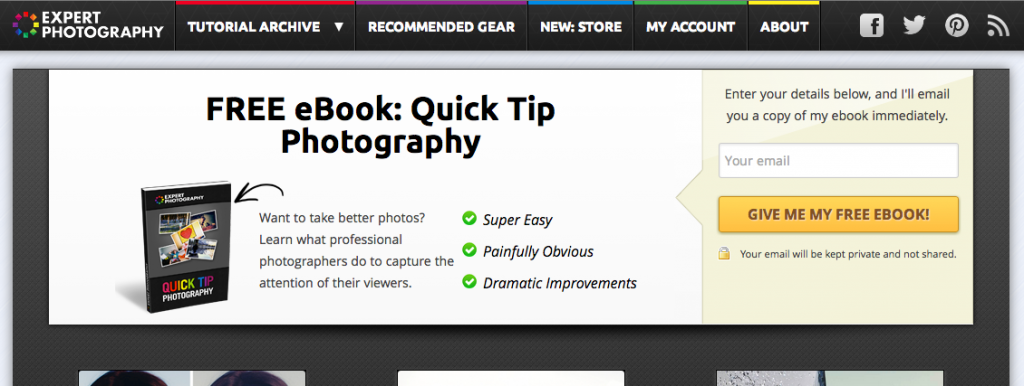
2 – Know the Value of a Subscriber
Big companies usually know this information really well, but it shouldn’t be too hard for you to work out.
You’re first going to need the list size of about 1,000 people, as it’s a good sample size that you can extract some data from.
After you’ve had the list for a while, and you’ve sold to them, add up how much money you’ve made. From your own products, and affiliate products. (Of course, there’s till money left in the list, but it’s best to be conservative). This will give you the minimum value of each subscriber.
Lets say your list of 1,000 people earned you $1,500.
That means that everyone on your list is worth at least $1.50, and that’s really useful information to have when it comes to buying subscribers.
3 – ‘Buying’ Subscribers Is Cheap
I have used Facebook ads to find subscribers many times in the past. It’s a really simple process.
You set up a squeeze page using OptimizePress, with your offer (which comes through in the first autoresponder message), and then simply drive your Facebook ad traffic there and watch it convert.
Speaking from experience, I usually only pay about 20¢ per click on my ads, and my squeeze page has at least a 33% conversion rate. This means that it costs me about 50¢ for every new subscriber.
If my subscriber is worth $1.50, and it only costs me 50¢ to obtain them, I’m going to triple my money.
This is the importance of knowing your numbers.
Of course, there’s more to the picture than this, but we’ll get to that.
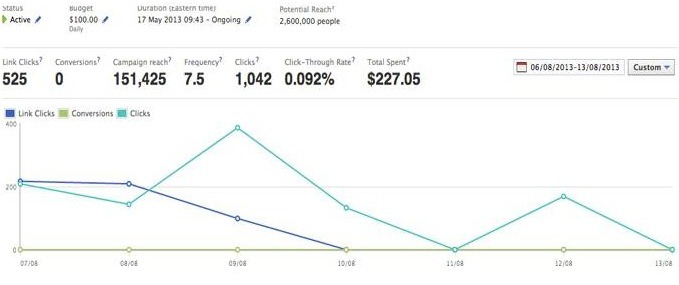
4 – Know Your Market
If you’re going to pay for Facebook ads, you really ought to know your target market first.
Do you have an avatar of your average customer? This is the sort of person you need to be targeting.
I only target people who can afford to buy whatever I’m selling. That means narrowing down my ads to only appear to people who speak English, live in English speaking countries, and are above a certain age.
I don’t want to target anyone under the age of about 25 really, as they tend not to have the sort of disposable income required to purchase my products.
I want a list of potential buyers.
5 – Collect Their Name
This is something I stopped doing a while back, on one of my lists, and I regret it.
It’s easier to get people to sign up with just an email address, but it’s not really ideal as you have a much stronger connection with someone when you talk to them by name.
They’re drawn to their name when they see it, and they will feel like you know them, rather than treat you like some stranger from the internet (which you probably are).
I’m going to be going back to collecting names pretty shortly, when I implement my new marketing strategy.
6 – Get Them to Reply To You
If you can get people to reply to you, they’re much more likely to buy from you, in my experience.
In my first email, I ask them a question, saying ‘If I could write about one thing to help you with your photography, what would it be?’.
When they reply, I’m getting them to complete an action that I’ve asked them to do, this is so they’re used to following my actions, such as ‘Click Add to Cart Now’.
When I reply back, I make a personal connection and now they know I’m a real person. A real person who’s proved that they can help them with their problems.
That’s really powerful for me, as I try to sell them a solution to their problems, in a couple of days time.
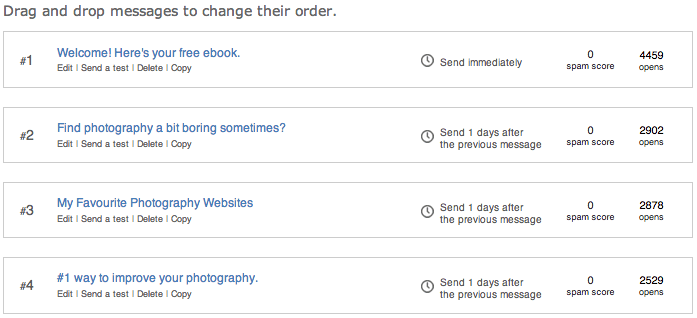
7 – Email Them Often
Those online who are emailing daily, are easily outselling those who don’t. And it makes sense really.
Who are you more likely to buy from: someone who teaches you something new every day, replies to your emails, and have a personal connection with…. or someone whose list you signed up to a few months ago, and haven’t heard from since.
Seriously, I spend maybe half an hour a day emailing my list, and I’ve not a never-ending list of tutorials and tips I can share with people. Most times I’m not even selling either, which makes it even more powerful when I do.
And trust me, people appreciate your emails.

8 – Don’t Be Afraid To Sell
Look, you’ve collected this list because you want to make sales, not friends.
I understand that you don’t want to annoy your subscribers, or maybe you’ve gotten a cranky reply in the past, and that’s maybe put you off, but don’t worry about it.
Email them every day, and sell to them often, until they either unsubscribe or buy something.
Otherwise, they’re just taking up room on a list you’re paying for.
The money is certainly in the list, buy you have to ask for it.
Unsubscribes are OK.
Think of it this way: if they unsubscribe from your list, then you’re no longer paying for them to be on there, and they were never going to buy anything anyway.
Being worried about unsubs is something that will hold you back in your email marketing.
9 – Listen to Your Mailing Provider (and Backup)
Love ’em or hate ’em, they’re in charge.
If your emails get too many complaints (marked as spam), then they’re not going to be happy hosting the list.
In Aweber, and I’m sure many other email list providers, they have something called a spam score. It looks over your subject line and scores it, depending on whether it thinks it’s too spammy or not.
Listen to this, and try to get the best score possible, because it knows from experience what’s going to get complaints, and what’s not.
They will contact you if you’re not playing by their rules, and make sure you talk to them, so that you can reassure them you’re on the same page.
Lastly, make sure you back up your lists as often as possible. Because if you mess up one too many times, they may delete your account and not give you access to the list.
And you don’t want that.
10 – Write an Autoresponder!
The best digital product I’ve ever bought is something called the McIntyre Method by John McIntyre.
It teaches you how to write an amazing autoresponder sequence which converts and makes you a ton of money.
It’s the reason my writing has developed to become so easy to read too.
I mean, you’re on the final point of this post and you’re still reading it, right?
“If you do this one thing, I promise you’ll triple your business, and you’ll work a lot less… spend the next two weeks writing 1 year’s worth of followup.” – Perry Belcher
A good followup sequence takes the pressure off you to write every day, and it means that you only need to focus on growing your list.
The money is in the list.
Conclusion
This can be broken down to three different points.
1 – You need to build your list, in every way you can, starting yesterday!
I sound like a broken record, but if the money is in the list, then you need to start building a list.
Our most effective way of doing this is to turn website traffic into subscribers with PopUp Domination.
We use it to display a highly effective light-box popup to everyone who visits our website, offering a freebie, in return for their email address.
But there’s loads of other ways we use PopUp Domination too. We target different offers to different pages and categories, and we also use it to link visitors to other pages of the website, such as a sales page.
The list goes on.
2 – You need to email your list often.
Every time you have something you think your subscribers may be interested in, email them. You can’t expect them to buy from a stranger.
Something I like to do is just link to my front-end product at the bottom of every email. Last time I did that, I got 3 extra sales. That’s an extra $291.
3 – Learn how to write your emails so that they’re always opened, and easy to read.
My email writing style consists of short, well crafted sentences.
One sentence paragraphs.
And not too many big words either.
They’re easy to read, which means they’re more likely to get read.
And lastly, I always leave an open hook at the end of an email, which gets people to open the next one.
But I’ll tell you more about that in my next post…
That’s just the tip of the iceberg. I honestly can’t recommend the McIntyre Method enough.
The post 10 Lessons I Learned From My First 20,000 Email Subscribers appeared first on How To Make Money Online.
]]>The post 10 Little-Known Email Marketing Tips for Bloggers appeared first on How To Make Money Online.
]]>Santa.
That “stat” shouldn’t surprise you. Of course kids are going to open their presents. If only people opened their emails the same way.
Taking a closer look, I came up with four underlying reasons why all presents are opened and gathered ten relevant tips to help you improve the email marketing strategy for your blog.
The Likely Extent of Your Email Marketing Strategy
If you’re like most bloggers, you have an opt-in at the top of your sidebar. You have a couple dozen subscribers. And you consistently get a 20% open rate/8% click-through rate with emails that you send out sporadically every few weeks.
This is because you’ve focused on building a list without having a strategy for once you have one. I want to help you with that.
People Need to Expect and Anticipate Your Emails
Li’l Johnny is excited on Christmas morning because he expects to find a pile of presents. More importantly, he knows that those presents contain gifts that he’s been wanting for months.
1. Set Expectations in the Opt-In Area
Too many bloggers trick people into opting-in with a free gift only to barrage them with unrelated emails later. I don’t know about you, but I don’t open those emails.
If, however, you make it clear in your opt-in area that they’re also requesting to receive blog updates, then they’re going to expect and anticipate your emails.
Sure that might discourage people from opting-in, but there’s no value in having a list full of people who don’t want your emails.
See example:
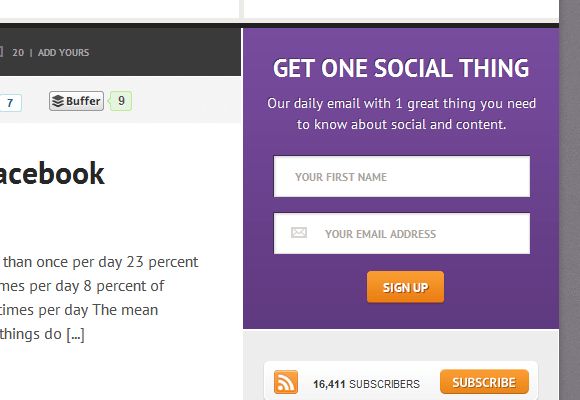
Jay Baer, from ConvinceandConvert.com, makes it clear that you’ll receive a daily email with social media advice.
2. Remind Them Why They’re Receiving Emails
Once they’re receiving your emails, it’s important to remind them why they’re receiving them. Otherwise you run the risk of them unsubscribing or marking your emails as spam.
A good way to do this is to put their signup date and signup URL in the footer of every email that you send. These two reminders will jog their memory to answer the question, “why am I getting these emails?”
See example:
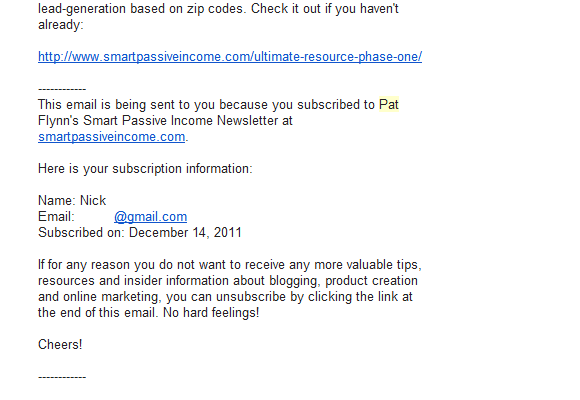
Pat Flynn, from SmartPassiveIncome.com, reminds his subscribers when and where they subscribed to his list in the footer of every email.
3. Send Your Emails Regularly at Consistent Times
What’s the best day and time to send an email to people around the world?
I schedule the emails for 6am EST so they’re at the top of the list when people open their inbox first thing in the morning across the US.
In the Income Diary Q&A, Josh Dunlop said,
I find that posting content at 9am West Coast time is best, because it’s lunch time on the East Coast and just after work in the UK, which are the biggest markets for my traffic.
People Need to Receive Your Emails Easily
All Johnny has to do to get his presents in the morning is wake up, climb down the stairs, and walk to the living room.
4. Create a Squeeze Page that You Can Direct People To
Having opt-ins in all of the popular areas (i.e. top sidebar, bottom sidebar, top of homepage, footer of post, etc.), is a good start.
You also want to have a page on your blog that’s dedicated to getting subscribers, also known as a squeeze page.
How come?
Because you and your readers can link to that page when you or they are recommending it to other people.
5. Link to Their Email System on Your Confirmation Page
After they fill out your opt-in form, they need to confirm their subscription.
This is the point where you typically say, “Before I can send you the information you requested, I need you to click the link in the email to confirm your subscription … yada, yada, yada.”
This page has one goal: Get them to open the email and confirm their subscription. Yet, few people ever optimize this small but pivotal step in the process.
How do you do that? Convince them to check their email immediately.
See example:
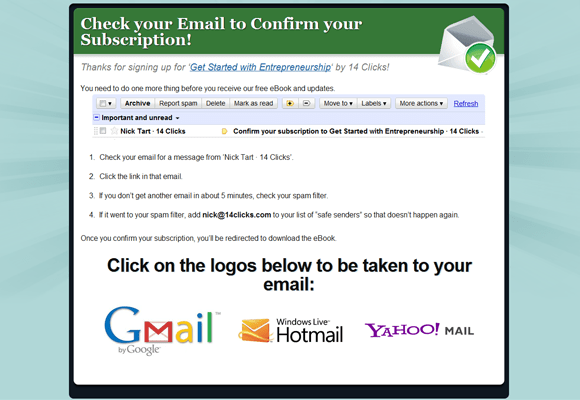
The confirm your subscription page on my blog, 14clicks.com, directs people to check their email immediately so they don’t forget.
6. Mobilize Your Emails with a Simple Text-Focused Email
According to Litmus.com, as of April 2012, 36% of email is opened with a mobile device and that number grew 80% in the previous six months.
You might fancy your 2-column, HTML email newsletters, but people who open them with their phones don’t.
To keep your emails mobile-friendly:
- Use a 1-column layout.
- No more than 550-600 pixels wide.
- Limit slow-loading images.
- If you link somewhere, try to make sure that the webpage is mobile-friendly.
See example:
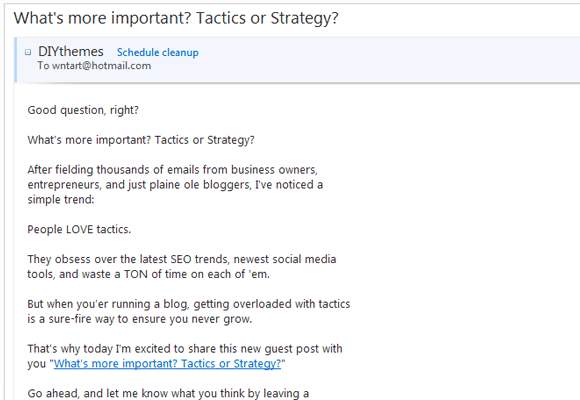
The DIYthemes email is HTML-based but simple enough that it appears to be text-based so it shows up well on mobile devices.
People Need to Feel a Personal Connection
The moment Johnny unwraps a Barbie Doll, he’s going to be forever skeptical about whether or not Santa really knows him. He’ll think twice about opening the next one. Around the third or fourth Barbie Doll, he’ll stop opening them altogether.
7. Segment Your Lists by Interests and Activity
How do you personalize a mass-communication channel?
Every email marketing service lets you create multiple lists. Create different lists based on the interests and activities of your audience.
Consider segmenting lists for:
- General blog subscribers.
- Weekly blog subscribers.
- Potential customers.
- Paying customers.
- Etc.
See example:
8. Use Your Welcome Email to Learn About Them
Aside from sending targeted emails based on interests, you also need to know who your audience is in order to build a personal connection with them.
One of the best ways to do that is to ask them to introduce themselves by replying to the first welcome email. Here are a few questions you can ask in that email:
- What are you struggling with right now?
- How do you expect me to help you?
- What types of content would get you to open every email?
See example:
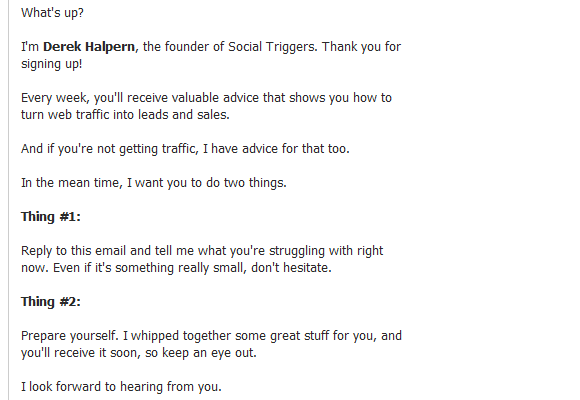
This is Derek Halpern’s Welcome Email for SocialTriggers.com. Many of his subscribers reply to this email with their #1 struggle. This let’s him meet his new subscribers and gives him a better understanding of how to help his audience.
People Need to Value Your Emails
In the weeks leading up to Christmas, Johnny circles his favorite toys in the catalogs, creates a list of his favorites, and even visits Santa to tell him what’s at the top of his list. All of this to ensure that he gets exactly what he wants.
9. Include Subscriber-Only Tips through an Autoresponder
What reason does somebody have to subscribe if they can get all of the same content by regularly visiting or following you on Twitter?
To treat your subscribers to something special, set up an autoresponder series that gives them a comprehensive guide for information that they want.
See example:
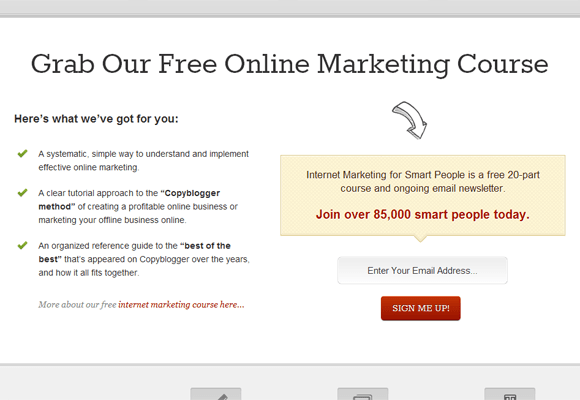
Copyblogger.com offers an exclusive, 20-part autoresponder series to their subscribers that’s based on years of researching their audience to figure out what they need help with most.
10. Offer a Weekly Email Option
I don’t know about you, but I have a tough time keeping up with reading the posts from all of my favorite blogs.
To get around this, consider offering a weekly subscription option to your readers. That way they can get one email with summaries of that week’s posts and choose to read the ones that are relevant to them.
See example:
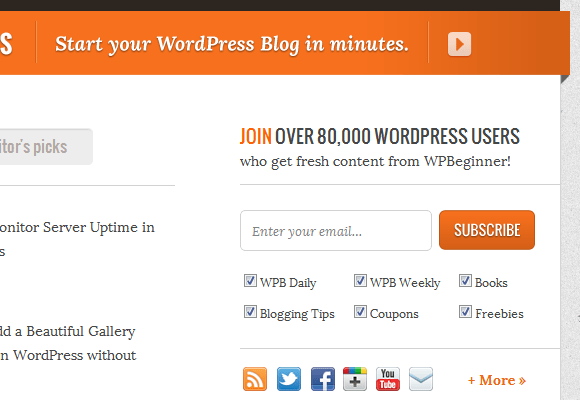
You’ll also notice that WPBeginner gives people the “WPB Daily” and “WPB Weekly” options because he understands that not every post is relevant to every subscriber.
How to Use Email Marketing
Email marketing has two functions.
- To get to know your audience.
- To send people your message.
Too many bloggers put too much focus on building their lists. Once they have a list, they don’t know what to do with it. So that list sits there and costs money.
I hope I’ve shed some light on this all-too-common problem and given you some ideas on how to improve your email marketing strategy. If I have, let me know in the comments.
As always, if you need help with implementing any of these tips, leave a comment and tell me which email marketing service you use.
Read more: ‘The Best Way To Grow Your Email List’
Photo by: Stuck in Customs
The post 10 Little-Known Email Marketing Tips for Bloggers appeared first on How To Make Money Online.
]]>